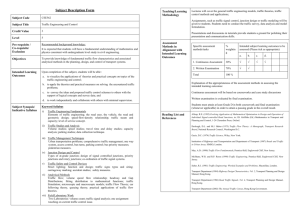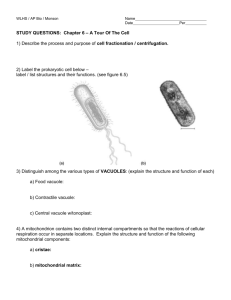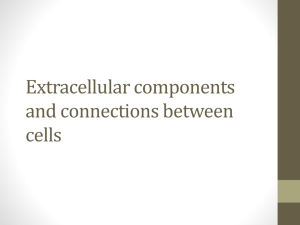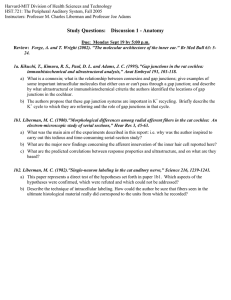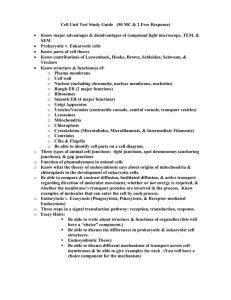Y.Y. Divin et all
advertisement
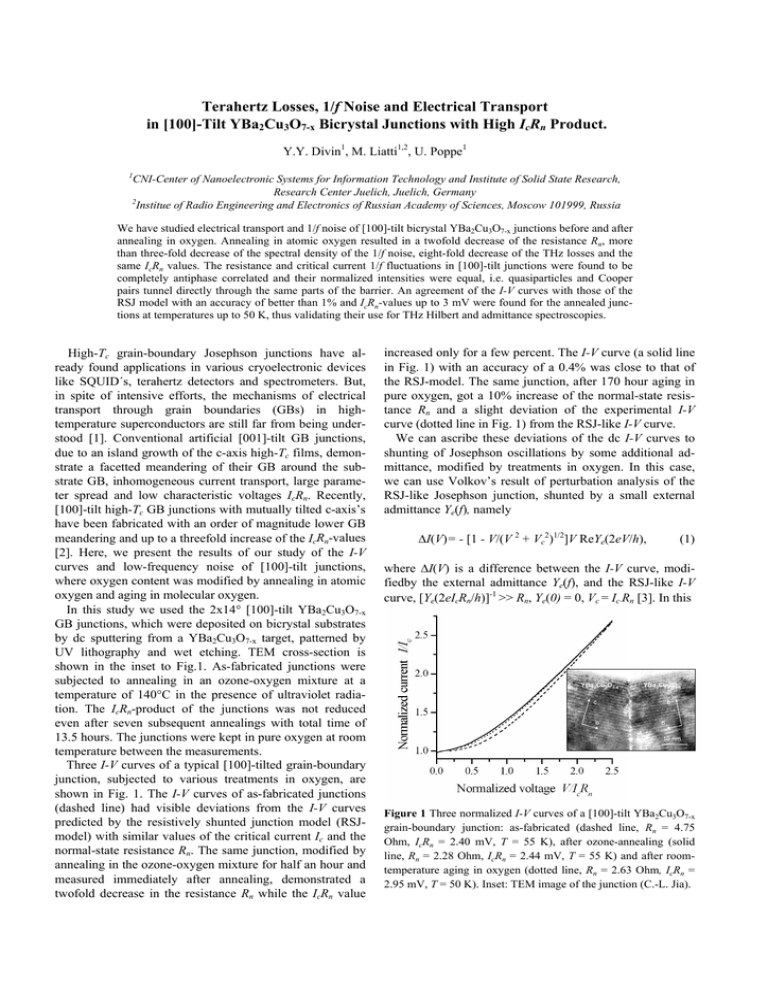
Terahertz Losses, 1/f Noise and Electrical Transport in [100]-Tilt YBa2Cu3O7-x Bicrystal Junctions with High IcRn Product. Y.Y. Divin1, M. Liatti1,2, U. Poppe1 1 CNI-Center of Nanoelectronic Systems for Information Technology and Institute of Solid State Research, Research Center Juelich, Juelich, Germany 2 Institue of Radio Engineering and Electronics of Russian Academy of Sciences, Moscow 101999, Russia We have studied electrical transport and 1/f noise of [100]-tilt bicrystal YBa2Cu3O7-x junctions before and after annealing in oxygen. Annealing in atomic oxygen resulted in a twofold decrease of the resistance Rn, more than three-fold decrease of the spectral density of the 1/f noise, eight-fold decrease of the THz losses and the same IcRn values. The resistance and critical current 1/f fluctuations in [100]-tilt junctions were found to be completely antiphase correlated and their normalized intensities were equal, i.e. quasiparticles and Cooper pairs tunnel directly through the same parts of the barrier. An agreement of the I-V curves with those of the RSJ model with an accuracy of better than 1% and IcRn-values up to 3 mV were found for the annealed junctions at temperatures up to 50 K, thus validating their use for THz Hilbert and admittance spectroscopies. High-Tc grain-boundary Josephson junctions have already found applications in various cryoelectronic devices like SQUID´s, terahertz detectors and spectrometers. But, in spite of intensive efforts, the mechanisms of electrical transport through grain boundaries (GBs) in hightemperature superconductors are still far from being understood [1]. Conventional artificial [001]-tilt GB junctions, due to an island growth of the c-axis high-Tc films, demonstrate a facetted meandering of their GB around the substrate GB, inhomogeneous current transport, large parameter spread and low characteristic voltages IcRn. Recently, [100]-tilt high-Tc GB junctions with mutually tilted c-axis’s have been fabricated with an order of magnitude lower GB meandering and up to a threefold increase of the IcRn-values [2]. Here, we present the results of our study of the I-V curves and low-frequency noise of [100]-tilt junctions, where oxygen content was modified by annealing in atomic oxygen and aging in molecular oxygen. In this study we used the 2x14° [100]-tilt YBa2Cu3O7-x GB junctions, which were deposited on bicrystal substrates by dc sputtering from a YBa2Cu3O7-x target, patterned by UV lithography and wet etching. TEM cross-section is shown in the inset to Fig.1. As-fabricated junctions were subjected to annealing in an ozone-oxygen mixture at a temperature of 140°C in the presence of ultraviolet radiation. The IcRn-product of the junctions was not reduced even after seven subsequent annealings with total time of 13.5 hours. The junctions were kept in pure oxygen at room temperature between the measurements. Three I-V curves of a typical [100]-tilted grain-boundary junction, subjected to various treatments in oxygen, are shown in Fig. 1. The I-V curves of as-fabricated junctions (dashed line) had visible deviations from the I-V curves predicted by the resistively shunted junction model (RSJmodel) with similar values of the critical current Ic and the normal-state resistance Rn. The same junction, modified by annealing in the ozone-oxygen mixture for half an hour and measured immediately after annealing, demonstrated a twofold decrease in the resistance Rn while the IcRn value increased only for a few percent. The I-V curve (a solid line in Fig. 1) with an accuracy of a 0.4% was close to that of the RSJ-model. The same junction, after 170 hour aging in pure oxygen, got a 10% increase of the normal-state resistance Rn and a slight deviation of the experimental I-V curve (dotted line in Fig. 1) from the RSJ-like I-V curve. We can ascribe these deviations of the dc I-V curves to shunting of Josephson oscillations by some additional admittance, modified by treatments in oxygen. In this case, we can use Volkov’s result of perturbation analysis of the RSJ-like Josephson junction, shunted by a small external admittance Ye(f), namely ∆I(V)= - [1 - V/(V 2 + Vc2)1/2]V ReYe(2eV/h), (1) where ∆I(V) is a difference between the I-V curve, modifiedby the external admittance Ye(f), and the RSJ-like I-V curve, [Ye(2eIcRn/h)]-1 >> Rn, Ye(0) = 0, Vc = Ic⋅Rn [3]. In this Figure 1 Three normalized I-V curves of a [100]-tilt YBa2Cu3O7-x grain-boundary junction: as-fabricated (dashed line, Rn = 4.75 Ohm, IcRn = 2.40 mV, T = 55 K), after ozone-annealing (solid line, Rn = 2.28 Ohm, IcRn = 2.44 mV, T = 55 K) and after roomtemperature aging in oxygen (dotted line, Rn = 2.63 Ohm, IcRn = 2.95 mV, T = 50 K). Inset: TEM image of the junction (C.-L. Jia). Figure 2 Real part of the shunting admittance ReYe as a function of voltage and corresponding Josephson frequency for asfabricated (dashed line), ozone-annealed (solid line) and aged (dotted) [100]-tilt junctions. approach, the deviations of the I-V curve are determined by the real part of the admittance ReYe(2eV/h), i.e. by losses. Three spectral dependences of ReYe have been derived from the I-V curves shown in Fig. 1 and are presented in Fig. 2. All three ReYe(f)-dependences have their maximum at the frequencies f ≅ 1.5 THz (V ≅ 3 mV). The maximum values of ReYe decreased from 0.076 Ω-1 for an asfabricated junction to 0.009 Ω-1 for ozone-annealed junction. Room-temperature aging resulted in a small Rn increase of 13 % and in a more pronounced increase of the losses from 0.009 Ω-1 to 0.05 Ω-1. We have studied low-frequency noise in the [100]-tilt junctions, because noise statistics can give additional data on the current transport. Typical voltage noise spectra Sv(f) are show in the inset in Fig.3. The low-frequency voltage noise in YBa2Cu3O7-x grain-boundary junctions is usually associated with normal-state resistance fluctuations δRn and fluctuations δIc of the critical current [4]. Using a standard formalism for the calculation of the spectral density of the sum of two random processes δIc and δRn [5], we have written the spectral power density of voltage noise as SV(f,I,V)=[Ic2Rd/I]2Si(f) + V2Sr(f) - 2k(f)Vc2[Sr(f)Si(f)]1/2, (2) where Rd = dV/dI is the differential resistance, Sr(f)= SRn(f)/Rn2 and Si(f) = SIc(f)/Ic2 are the normalized spectral densities of fluctuations δRn and δIc, correspondingly, k(f)=|γir(f)|cosθir(f) is a correlation coefficient between the fluctuations δRn and δIc, θir is a phase angle of the crossspectral density Sir, γir2(f)=|Sir(f)|2/[Si(f)Sr(f)]. The experimental noise data are presented in Fig. 3, where the normalized spectral densities SV/Ic2Rn2 at a frequency of 3 kHz are are plotted as a function of normalized voltage V/IcRn for as-fabricated (open circles), ozone-annealed (solid squares) and aged (open squares) junctions at the temperature (50±5) K. The values of Sr, Si and correlation coefficient k for each 2 Figure 3 Normalized noise spectral density Sv(V)/Ic2Rn2 at 3 kHz vs. normalized voltage V/IcRn for as-fabricated (open circles), ozoneannealed (solid squares) and aged (open squares) [100]-tilt YBa2Cu3O7-x junction. The best fits by (3) are shown by dashed, solid and dotted lines, correspondingly. Inset: Voltage noise vs. frequency for the same junction at temperatures from 7 to 75K. Junction voltages V = IcRn for each temperature. modification of the junction were obtained by fitting (2) to the experimental data by a nonlinear fitting procedure. The results of fitting experimental data by (2) are shown in Fig. 3 by different lines. The noise characteristics of asfabricated, ozone-annealed and room-temperature-annealed junctions demonstrated good agreement with (2). Annealing in atomic oxygen resulted in a threefold decrease of Sr and a sixfold decrease of Si values. Room-temperature aging in molecular oxygen for a week resulted in only 25% increase of the Sr-value and 65% of the Si-value. The as-fabricated, ozone-annealed and aged junctions had a correlation coefficient k equal to –1 within an instrumental accuracy (±0.2) and a value of the ratio p = (Si/Sr)1/2 close to 1 [6,7]. Comparing with available models of high-Tc GB, our data are more consistent with a model, where both quasiparticles and Cooper pairs tunnel through the same barrier, formed by band bending at the superconductorboundary interface [1]. To include 1/f voltage noise into this model, the fluctuations of trapped charge at the interface might be considered like in semiconductor GBs [8]. [1] H. Hilgenkamp, J. Mannhart, Rev. Mod. Phys. 74 (2002) 485. [2] Y. Y. Divin, U. Poppe, C.L. Jia, P.M. Shadrin, K. Urban, Physica C 372-376 (2002) 115. [3] A. F. Volkov, Radiotekhnika i Elektronika, 17 (1972) 2581(in Russian). [4] M. Kawasaki, P. Chaudhari, and A. Gupta, Phys. Rev. Lett., vol. 68, pp. 1065-1068, 1992. [5] J. S. Bendat, Random Data: Analysis and Measurement Procedures New York: Wiley, 2000, ch. 5 [6] M.V. Liatti, U. Poppe, Y.Y. Divin, Appl. Phys. Lett. 88 (2006) 152504. [7] M.V. Liatti, U. Poppe, Y.Y. Divin, IEEE Trans. Appl. Supercond. (2007) accepted. [8] A.J. Madenach and J. Werner, Phys. Rev. Lett. 55 (1985) 1212.


